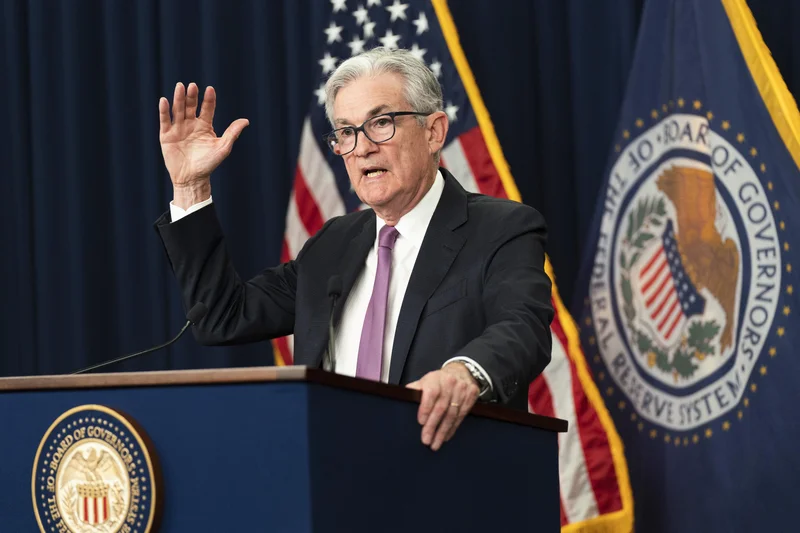Of course. Here is the feature article, written from the persona of Dr. Aris Thorne.
*
The Fed's Rate Cut Is a Sideshow. The Real Story Is Hiding in Plain Sight.
Any minute now, Jerome Powell will walk up to a podium, adjust his microphone, and the entire financial world will hold its breath. We’ll all lean into our screens, parsing every word, every subtle pause, for clues about a quarter-point interest rate cut. It’s the biggest show in economics, a high-stakes ritual where we collectively pretend that tweaking a single number can steer the colossal, chaotic ship of the U.S. economy.
But I have to be honest with you. This is all a sideshow.
We’re all obsessing over the wrong thing. While the world is busy debating the Fed’s next move, a much bigger, more profound story is unfolding, and it’s hiding in plain sight. We’re arguing about the weather forecast while a tectonic plate shifts beneath our feet. The real story isn’t about interest rates; it’s about the fundamental rewiring of our economic reality.
Flying Blind With an Old Map
Let’s be fair to the Fed. They’re in an impossible position. They’re trying to navigate what Powell himself has called a “curious kind of balance.” On one hand, hiring has slowed to a crawl, with job gains averaging a paltry 29,000 a month. On the other, inflation, while cooling, remains stubbornly elevated. And to make matters worse, a government shutdown has effectively turned off their GPS. They’re flying blind, with key reports on jobs and inflation delayed or even canceled.
One analyst described it as driving in a winter storm and losing visibility. It’s a good metaphor, but I don’t think it goes far enough. It’s more like driving in a blizzard using a paper map from 1995. The roads have changed, entire new cities have sprung up, and the old landmarks are gone.
The Fed’s map is based on a 20th-century economic model. It operates on a dual mandate—in simpler terms, its two main jobs are to keep prices stable and make sure people can find work. For decades, those two goals were in a predictable dance. But what happens when the dance floor itself is changing? What if the very nature of “work” and “growth” is transforming so quickly that the old signals are becoming meaningless noise?

That’s the question nobody seems to be asking. Instead, we’re stuck in an endless loop: will they cut by a quarter-point? What about December? It feels like we’re trying to fix a software bug by fiddling with the computer’s power cord.
The Ghost in the Economic Machine
Buried deep within one of the wire reports was a single line that made me sit back in my chair. Honestly, it’s the kind of sentence that reminds me why I got into this field in the first place. It noted that the economy’s “mostly solid growth is heavily dependent on massive investment by leading tech companies in artificial intelligence infrastructure.”
Read that again. This isn’t just another tech boom. This is different. This is the equivalent of the great railroad expansion of the 19th century or the electrification of the country in the 20th. We are witnessing, right now, the construction of a new foundational layer for our entire civilization—an intelligence layer. The capital isn't just flowing into apps or gadgets; it's being poured into the concrete and silicon that will power the next century of progress.
This changes everything. It reframes the entire economic puzzle. That “low-hire, low-fire” job market that has economists so confused? It’s not an anomaly; it’s a preview. Companies aren’t hiring thousands of people for yesterday’s jobs because they are investing billions in the AI systems that will create tomorrow’s industries—industries we can’t even name yet. This is a profound, almost silent, realignment of capital and labor, and it’s happening at a speed that is just staggering—it means the gap between the economy we measure and the economy we’re building is growing wider every single day.
Of course, this kind of paradigm shift isn't without its challenges. It demands that we think seriously about education, skills, and how we support people through a period of immense change. We can’t just build this incredible new world and leave millions behind. The responsibility is enormous. But the opportunity? It’s boundless.
We're not in a sluggish recovery. We are in the earliest days of an AI-driven renaissance. The solid growth that baffles economists isn’t a mystery; it’s the sound of a new world being built.
We're Arguing About the Thermostat While the House Is Being Rebuilt
So, yes, the Fed will almost certainly cut rates. Markets will rally or dip for a few hours. Pundits will declare winners and losers. And none of it will really matter.
Focusing on a quarter-point rate cut right now is like arguing about the color of the drapes while the foundation of a skyscraper is being poured outside your window. The real question isn’t what Jerome Powell will say today. The question is, are we ready for what comes next? Are we prepared to adapt our institutions, our education, and our own thinking for an economy powered not just by human labor, but by artificial intelligence?
The infrastructure for the future is being laid right now. It’s the biggest economic story of our lifetime, and it’s time we started paying attention to it.
